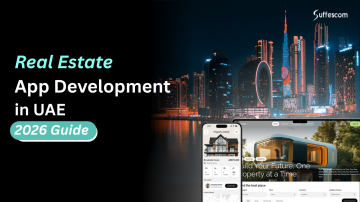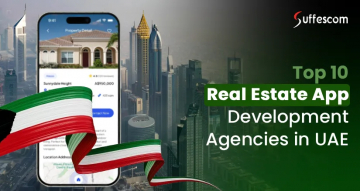AI MVP Development: A Step-by-Step Guide For Businesses

Artificial Intelligence (AI) is revolutionizing how businesses innovate, automate, and scale in today’s rapidly evolving digital landscape. However, building a full-scale AI product can be resource-intensive, complex, and risky—especially if the core idea hasn’t been validated in real-world conditions. This is where the concept of an AI MVP (Minimum Viable Product) becomes crucial.
An AI MVP is a simplified version of an AI-powered application that includes only the core features necessary to solve a specific problem and demonstrate the value of your AI solution. It allows startups and enterprises to test their ideas, validate assumptions, and gather user feedback with minimal time and cost investment.
This guide provides a practical, step-by-step approach to AI MVP development. It helps you avoid common pitfalls, align your efforts with user needs, and lay the groundwork for a scalable, data-driven product. Whether you’re a startup founder or a product manager in a tech-driven enterprise, these steps will help you move from concept to validation efficiently and effectively.
What Is an AI MVP?
A Minimum Viable Product (MVP) in the context of AI is a lightweight, functional version of a product that leverages artificial intelligence to solve a specific problem. Unlike traditional software MVPs, which often focus on delivering a usable interface, an AI MVP must demonstrate that its underlying model can provide value, even at an early stage.
An Artificial Intelligence Minimum Viable Product helps validate your idea in real-world conditions before you commit to a full-fledged product. Rather than investing heavily in building complex AI systems, you create a simplified version focusing on solving one core problem. This could involve predictive analytics, recommendation systems, or even generative AI development for content creation, design generation, or conversational experiences that let you gather early user feedback, understand real performance, and test key assumptions.
Launch Faster with Our AI MVP Development Services
Don’t waste months on uncertain development—our white-label solutions and custom builds get your AI product to market fast
Why Building an AI MVP Is Essential?
AI fundamentally differs from traditional software development. Unlike static codebases, AI systems evolve through data exposure, iterative learning, and continuous feedback. This dynamic nature necessitates a strategic approach to product development, making the concept of an MVP particularly crucial for AI.
Launching a full-scale AI product without prior validation poses significant risks. By developing an AI MVP, organizations can:
Quickly Test the Concept's Viability
Nearly 72% of startups use MVPs to gather early feedback, refine product direction, and reduce costly missteps, keeping the focus on actual user needs.
Identify Data Challenges Early
AI depends heavily on high-quality data. An MVP highlights data availability, quality, and structure gaps, which are critical for model success.
Gather Valuable Feedback
Around 70% of companies report that MVPs improve their understanding of users, leading to smarter product decisions and better model tuning.
Showcase Real-World Traction
MVPs can boost credibility with stakeholders. Startups that follow MVP strategies achieve 67% higher funding success and 2–3x faster market entry.
Benefits of Developing an AI MVP
Building an AI MVP offers a strategic advantage for startups and enterprises aiming to harness AI without taking excessive risks. Below are the key benefits:
1. Faster Time-to-Market
An AI MVP enables teams to focus solely on essential features, significantly reducing the development timeline. This allows you to launch quickly, start testing the product in real environments, and iterate based on actual user behavior, which is crucial for staying ahead in competitive markets.
2. Cost-Efficiency
By concentrating resources on core functionalities, companies can minimize initial investment and avoid building features that users may not need. This lean approach helps allocate budgets more effectively, especially for AI projects where model training and data handling can be costly.
3. Real-World Validation
An AI MVP lets you validate your solution with real users instead of solely on assumptions or internal testing. Early feedback on AI performance, accuracy, and relevance helps refine the model and ensures the solution genuinely solves user problems.
4. Early Risk Identification
Launching an MVP allows you to identify data-related challenges, technical limitations, and integration issues early in the development cycle. Catching these problems at the MVP stage is far less expensive and time-consuming than during full-scale product rollout.
5. Stakeholder Confidence and Investor Buy-In
Demonstrating traction with an AI MVP—through user engagement, improved model performance, or measurable outcomes—can make your concept more credible. This tangible proof of concept is often essential to securing stakeholder confidence or attracting investors.
6. Continuous Learning and Improvement
AI systems improve over time with exposure to diverse data and user interactions. An MVP facilitates a feedback loop where the model continuously learns and evolves, helping you build a more intelligent, responsive, and scalable product.
Steps to Build an AI MVP For Startups and Businesses
Step 1: Define the Problem and Validate the Idea
Identify a single, well-defined problem your AI solution will address. Conduct market research, study competitors, and engage with potential users to ensure the issue is real and worth solving. Validation at this stage prevents building a product no one needs.
Step 2: Plan Your AI MVP
Outline the specific AI capabilities required, such as machine learning, NLP, or computer vision. For advanced language processing tasks, many teams choose to hire NLP developers to ensure specialized expertise. Identify the type and source of data you'll need. Select relevant tools and frameworks and define success metrics to measure performance and user impact.
Step 3: Design the MVP
Create simple wireframes and user flows demonstrating how users interact with the AI component. Focus on user experience and functionality, ensuring the AI is integrated naturally into the design without overwhelming the user.
Step 4: Develop the MVP
Build only the essential features needed to solve the core problem. Integrate a functional AI model using real or synthetic data, ensuring it works reliably under expected conditions. Keep the code modular to allow for future improvements.
Step 5: Test with Real Users and Collect Feedback
Release the AI-Powered MVPs into a limited group of target users. Monitor how they use the product, gather direct feedback, and track AI performance. Use this data to understand real-world usability, accuracy, and pain points.
Step 6: Refine and Iterate Based on Feedback
Analyze user feedback and performance data to fine-tune the AI model and product features. Prioritize improvements that enhance usability and model reliability. Continue this cycle until the MVP proves strong market fit and technical viability.
For clients seeking faster launches, a White Label MVP App offers a ready-to-deploy solution, significantly reducing development time and cost. Ideal for startups or businesses aiming to validate ideas quickly, a custom AI development company can tailor the white-label MVP to match your branding and functionality requirements, ensuring a rapid go-to-market strategy without compromising quality.
Bonus Read - How To Build AI Software
How Much Does it Cost to Build an AI MVP?
Creating an AI MVP isn't solely about reducing expenses—it's about achieving maximum impact with the least investment. The overall ai cost, much like in any AI-driven MVP development scenario, hinges on several key factors: the complexity of the AI model, the availability and quality of data, infrastructure requirements, and the makeup of the development team. Let's take a closer look.
Key Cost Factors for Building an AI MVP
1. Data Collection & Preparation
Data is the backbone of any AI model, and its acquisition and preparation can be costly, depending on whether you use open-source datasets, collect and label data manually, or purchase proprietary data.
Open-source datasets: Free
Manual data collection & labeling: $2,000 – $10,000
Proprietary datasets: $10,000 – $25,000
2. AI Model Development ($5,000 – $25,000)
The complexity of your AI model directly influences the development cost.
Rule-based systems: $5,000 – $10,000
Fine-tuned pre-trained models: $10,000 – $20,000
Custom machine learning models: $20,000 – $25,000
3. AI Infrastructure & Cloud ($500 – $30,000)
Training AI models requires powerful computing resources, usually leading to high infrastructure costs.
Local training on basic server: $500 – $5,000
Cloud services (AWS, Google Cloud, Azure): $5,000 – $20,000
Enterprise-grade infrastructure: $20,000 – $30,000
4. MVP Frontend & Backend Development ($7,000 – $25,000)
Even with advanced AI functionality, a basic user interface is essential to test user interactions.
Basic web app or API: $7,000 – $10,000
Mobile app or dashboard: $10,000 – $25,000
5. Team & Talent Costs ($25 – $90)
AI/ML Engineers: $80–$100/hr
Backend Developers: $25–$50/hr
Frontend Developers: $30–$60/hr
Data Scientists: $45–$90/hr
Best Practices in AI MVP Development
Here are some best practices you and your professional MVP development company should follow to ensure a successful and efficient product launch:
Start with a Clear Use Case
Clearly define what problem the AI MVP is solving, and ensure the solution is achievable with available data and technology.
Use High-Quality and Relevant Data
AI performance is directly tied to data quality. Use clean, labeled, domain-specific datasets to ensure your MVP delivers meaningful results.
Keep the Scope Minimal
Focus on the core functionality that demonstrates your AI's value. Avoid adding extra features that can distract from the MVP's primary goal.
Choose the Right AI Model and Tools
Select models that suit your use case and use proven frameworks or platforms to reduce development time and technical risk.
Build for Feedback Loops
Ensure your MVP application includes mechanisms to collect user input and model performance data. These insights are vital for training, tuning, and improving the AI.
Ensure Explainability and Transparency
Incorporate explainable AI features to help users understand how decisions are made, primarily if the MVP affects critical decisions like finance or healthcare.
Monitor and Iterate Continuously
Track usage, errors, and outcomes using real-time analytics. Iterating based on these insights helps your AI MVP evolve into a production-ready solution.
Prioritize User Experience
Even with a functional AI, poor UX can lead to rejection. Ensure interactions are intuitive, and the AI enhances rather than complicates the user journey.
Minimize Risk, Maximize Impact with a Lean AI MVP
We help startups and enterprises build scalable, AI-powered MVPs that drive real-world results. Start Your AI Journey Now!
Common Pitfalls to Avoid While Developing an AI MVP
Lack of Problem Clarity
Starting development without a clearly defined and validated problem often leads to building solutions no one needs. The AI MVP must solve a specific, real-world pain point.
Overengineering the MVP
Adding too many features or optimizing the model excessively defeats the purpose of building a lean, testable MVP. Focus on the "minimum" part first, then expand.
Ignoring Data Limitations
AI is data-dependent. Using insufficient, biased, or poor-quality data can undermine the model's performance. It's essential to assess your data readiness early on.
Choosing the Wrong AI Model
Using an overly complex or inappropriate model for a simple problem increases development time and technical debt. Choose models that align with your MVP's scope.
Skipping User Feedback
Building in isolation without testing with real users limits your ability to learn. User feedback is essential for refining both UX and AI accuracy.
Neglecting AI Explainability
A lack of transparency in how AI makes decisions, especially in sectors like finance or healthcare, can hinder user trust and adoption. Always account for explainability.
Poor Evaluation Metrics
Tracking incorrect or overly technical metrics (like only accuracy) without linking them to user or business outcomes can give a false sense of progress. Use actionable KPIs.
Lack of Iteration
Treating the MVP as a one-time project rather than an iterative product prevents improvement. MVP AI should evolve based on performance and user feedback.
Underestimating Integration Challenges
AI is rarely standalone—it must integrate with existing workflows, APIs, and platforms. Overlooking these integration needs can delay launches or break functionality.
Inadequate Model Monitoring
Once deployed, AI models may degrade over time due to data drift or changing patterns. Without proper monitoring, this can go unnoticed and reduce product quality.
Focusing Too Much on Technology
AI excitement often leads to tech-first thinking. However, user experience, usability, and interface design should be just as crucial as model performance.
Ignoring Ethical and Regulatory Considerations
Failing to comply with data privacy laws (like GDPR) or ethical standards (bias, fairness) can lead to legal consequences and reputational damage.
No Clear Path to Scalability
Some MVPs are built in ways that can't scale—due to manual data processing, hard-coded logic, or lack of automation. Even MVPs should have a long-term vision.
Conclusion
Building intelligent AI models and an AI MVP is not just a technical exercise—it's a strategic approach that helps teams validate ideas, minimize risk, and create real value from artificial intelligence. By focusing on solving a specific problem with minimal yet functional features, an AI MVP enables faster iteration, better user feedback, and a stronger foundation for future scaling.
Whether launching a startup or innovating within an enterprise, following a structured, step-by-step process ensures your AI solution is technically sound and market-ready. As AI technologies evolve, staying lean, user-focused, and data-driven will be the key to building successful AI-powered products.
FAQs
1. How to build an AI MVP?
Building an AI MVP involves creating a simplified version of your AI product to validate the core idea quickly and cost-effectively. Here's how to do it:
- Define the core problem your AI solution will solve.
- Gather relevant data using open-source, manual, or proprietary sources.
- Choose the right AI approach (e.g., machine learning, NLP, computer vision). Use pre-trained models or APIs to reduce time and cost.
- With the help of an AI MVP development company, develop a basic frontend or API to demonstrate the functionality.
- Test with real and beta users to gather feedback and validate the concept.
- Track key metrics like accuracy, performance, and user satisfaction.
- Iterate quickly to improve the model and interface based on feedback.
2. What kind of businesses should consider AI MVP development?
Startups validating innovative AI ideas and established businesses exploring AI-driven automation or personalization are ideal candidates. Industries like healthcare, fintech, eCommerce, EdTech, and logistics commonly benefit from an AI MVP.
3. Do I need a lot of data to build an AI MVP?
Not necessarily. While high-quality data is crucial, many MVPs start with synthetic data, small datasets, or third-party APIs to assess data readiness early and scale collection as the product matures.
4. How much does it cost to build an AI MVP?
The cost to build an AI MVP varies based on complexity, features, data requirements, and the level of AI integration. On average, the cost can range from $10,000 to $30,000.









